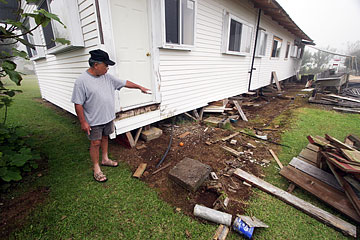FEMA tallies $35M bill for isle quake damage
Those isolated along Hana Highway and Paihi Bridge get relief
The Federal Emergency Management Agency has verified $35 million in infrastructure damage in Hawaii from the Oct. 15 earthquakes, officials said yesterday.
The U.S. Small Business Administration has awarded another $23 million in low-interest loans to Hawaii businesses affected by the quake, FEMA said.
THE COST OF ISLE EARTHQUAKES
These are the latest tallies from federal agencies for damage from the Oct. 15 quakes:
» $35 million to roads, buildings and other infrastructure (of which 75 percent will be paid by FEMA)
» $23 million in SBA loans to businesses
» $9.2 million in assistance to individuals and families
TOTAL: $67.2 MILLION
Source: Federal Emergency Management Agency
|
An additional $9.2 million was distributed as of Jan. 15 to 2,595 individuals and families claiming damage or a loss of housing from the back-to-back quakes, said Kelly Hudson, a public-affairs specialist with the FEMA regional office in Oakland, Calif.
President Bush expanded his disaster relief declaration Tuesday to include disaster unemployment assistance to residents of Kaupo, Kipahulu and Hana, Maui, who were isolated for weeks after the quakes damaged the Hana Highway and Paihi Bridge.
"The president's amended declaration will ensure that the residents of Maui who need disaster assistance will get the help they need," said U.S. Sen. Daniel Inouye, D-Hawaii. "Their long wait will not have been in vain."
The quakes off the Big Island, with magnitudes of 6.7 and 6.0, caused extensive damage to Big Island roads, bridges, buildings, water and sewer lines, and an hours-long blackout on Oahu. The University of Hawaii alone claimed $2.5 million in quake-related damage.
Of the $35 million, FEMA will pay 75 percent as part of its public-assistance relief effort, said Hudson. The remainder typically is picked up by state and county governments, she said.
In individual assistance, $9,228,114 was distributed to renters for rental assistance and to "uninsured or underinsured" homeowners for repairs from quake damage, Hudson said. FEMA rental assistance can continue for up to 18 months, with the exact term subject to negotiation between the state and federal governments.

STAR-BULLETIN / OCTOBER 2006
Raymond Yamasaki points to where his Waimea house used to sit before it was shaken off its post-and-pier foundation. The Oct. 15 earthquakes moved his home about three feet; it was one in of the Big Island areas that suffered the most damage.
|
|
FEMA inspectors arrived soon after the quakes to join state officials in preliminary damage assessments for roads, bridges and other public infrastructure. Later inspections addressed damage to residences once individuals had registered for assistance, Hudson said.
Occurring seven minutes apart, the quakes had epicenters at different depths and were followed over the next 24 hours by more than 80 aftershocks with magnitudes greater than 1.7, according to the U.S. Geological Survey. The largest aftershock had a magnitude of 4.2.
The quakes were felt statewide but most strongly in North Kona and North and South Kohala. There were no resulting deaths.
The first quake was the largest in Hawaii since a 6.7-magnitude jolt under the east flank of Mauna Loa in November 1983. A 7.2-magnitude quake occurred under the south flank of Kilauea Volcano in November 1975.

